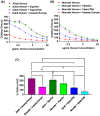Tiny but Mighty: Vipera ammodytes meridionalis (Eastern Long-Nosed Viper) Ontogenetic Venom Variations in Procoagulant Potency and the Impact on Antivenom Efficacies
- PMID: 39330854
- PMCID: PMC11436208
- DOI: 10.3390/toxins16090396
Tiny but Mighty: Vipera ammodytes meridionalis (Eastern Long-Nosed Viper) Ontogenetic Venom Variations in Procoagulant Potency and the Impact on Antivenom Efficacies
Abstract
The Eastern Long-Nosed Viper (Vipera ammodytes meridionalis) is considered one of the most venomous snakes in Europe. However, it is unknown whether ontogenetic variation in venom effects occurs in this subspecies and how this may impact antivenom efficacy. In this study, we compared the procoagulant activities of V. a. meridionalis venom on human plasma between neonate and adult venom phenotypes. We also examined the efficacy of three antivenoms-Viperfav, ViperaTAb, and Inoserp Europe-across our neonate and adult venom samples. While both neonate and adult V. a. meridionalis venoms produced procoagulant effects, the effects produced by neonate venom were more potent. Consistent with this, neonate venom was a stronger activator of blood-clotting zymogens, converting them into their active forms, with a rank order of Factor X >> Factor VII > Factor XII. Conversely, the less potent adult venom had a rank order of FXII marginally more activated than Factor VII, and both much more so than Factor X. This adds to the growing body of evidence that activation of factors besides FII (prothrombin) and FX are significant variables in reptile venom-induced coagulopathy. Although all three examined antivenoms displayed effective neutralization of both neonate and adult V. a. meridionalis venoms, they generally showed higher efficacy on adult venom than on neonate venom. The ranking of antivenom efficacy against neonate venom, from the most effective to the least effective, were Viperfav, Inoserp Europe, ViperaTAb; for adult venom, the ranking was Inoserp Europe, Viperfav, ViperaTAb. Our data reveal ontogenetic variation in V. a meridionalis, but this difference may not be of clinical concern as antivenom was effective at neutralizing both adult and neonate venom phenotypes. Regardless, our results highlight a previously undocumented ontogenetic shift, likely driven by the documented difference in prey preference observed for this species across age classes.
Keywords: Echis; antivenom; coagulopathy; factor activation; small-molecule enzyme inhibitor.
Conflict of interest statement
M.A. is an employee of antivenom producer Micropharm, and RS is employed by antivenom producer Inosan Biopharma, which made the products tested in this manuscript. However, none of the companies had input in experimental design or reviewing of results before publication. The other authors declare no conflicts of interest.
Figures



Similar articles
-
Snake Venom Makeover: Age-Dependent Variations in Procoagulant Biochemistry of Egyptian Saw-Scaled Viper (Echis pyramidum pyramidum) Venom.Toxins (Basel). 2025 Mar 19;17(3):149. doi: 10.3390/toxins17030149. Toxins (Basel). 2025. PMID: 40137922 Free PMC article.
-
Venom-Induced Blood Disturbances by Palearctic Viperid Snakes, and Their Relative Neutralization by Antivenoms and Enzyme-Inhibitors.Front Immunol. 2021 Jun 10;12:688802. doi: 10.3389/fimmu.2021.688802. eCollection 2021. Front Immunol. 2021. PMID: 34177943 Free PMC article.
-
Comparison of Preclinical Properties of Several Available Antivenoms in the Search for Effective Treatment of Vipera ammodytes and Vipera berus Envenoming.Toxins (Basel). 2021 Mar 13;13(3):211. doi: 10.3390/toxins13030211. Toxins (Basel). 2021. PMID: 33805701 Free PMC article.
-
Antivenom therapy of carpet viper (Echis ocellatus) envenoming: effectiveness and strategies for delivery in West Africa.Toxicon. 2013 Jul;69:82-9. doi: 10.1016/j.toxicon.2013.01.002. Epub 2013 Jan 20. Toxicon. 2013. PMID: 23339853 Review.
-
A Guide to the Clinical Management of Vipera Snakebite in Italy.Toxins (Basel). 2024 May 31;16(6):255. doi: 10.3390/toxins16060255. Toxins (Basel). 2024. PMID: 38922149 Free PMC article. Review.
Cited by
-
Snake Venom: Toxicology and Associated Countermeasures.Toxins (Basel). 2025 May 10;17(5):237. doi: 10.3390/toxins17050237. Toxins (Basel). 2025. PMID: 40423320 Free PMC article.
-
Snake Venom Makeover: Age-Dependent Variations in Procoagulant Biochemistry of Egyptian Saw-Scaled Viper (Echis pyramidum pyramidum) Venom.Toxins (Basel). 2025 Mar 19;17(3):149. doi: 10.3390/toxins17030149. Toxins (Basel). 2025. PMID: 40137922 Free PMC article.
-
Age Is Just a Number: Ontogenetic Conservation in Activation of Blood Clotting Factors VII, X, and XII by Caucasus Blunt-Nosed Viper (Macrovipera lebetina obtusa) Venoms.Toxins (Basel). 2024 Dec 2;16(12):520. doi: 10.3390/toxins16120520. Toxins (Basel). 2024. PMID: 39728778 Free PMC article.
References
-
- Kasturiratne A., Wickremasinghe A.R., de Silva N., Gunawardena N.K., Pathmeswaran A., Premaratna R., Savioli L., Lalloo D.G., de Silva H.J. The global burden of snakebite: A literature analysis and modelling based on regional estimates of envenoming and deaths. PLoS Med. 2008;5:e218. doi: 10.1371/journal.pmed.0050218. - DOI - PMC - PubMed
-
- World-Health-Organisation Snakebite Envenoming. [(accessed on 20 September 2019)]. Available online: https://www.who.int/news-room/fact-sheets/detail/snakebite-envenoming.
-
- Boyer L., Alagón A., Fry B.G., Jackson T.N.W., Sunagar K., Chippaux J.P. Signs, Symptoms and Treatment of Envenomation. In: Fry B.G., editor. Venomous Reptiles and Their Toxins: Evolution, Pathophysiology and Biodiscovery. Oxford University Press; New York, NY, USA: 2015. pp. 32–60.
Publication types
MeSH terms
Substances
Grants and funding
LinkOut - more resources
Full Text Sources

